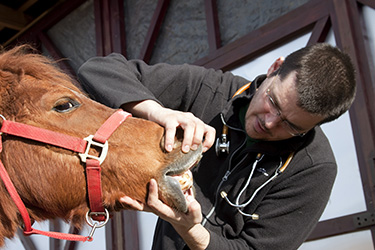Equine Dentistry: Diet, Sharp Points and Floating Tips

In horses, sometimes diet and dental problems go hand in hand. Fortunately, all it may take to resolve the issue is a thorough examination and a basic dental procedure called floating.
Diet and Nutrition
The diet of a horse is partially responsible for the wear of its teeth.
- Hays, grains and grasses are fibrous and contain silica which has an abrasive quality that will wear down the surface of a tooth.
- Once the surface becomes unevenly worn, sharp points will form to cause painful lacerations to the inside of the mouth, gums, and/or tongue.
- Alfalfa hay, for example, is a less fibrous and abrasive food, but can still create unevenly polished tooth surfaces.
- The uneven polishing forms raised edges on the sides of the molars which forces the animal to change its natural way of chewing.
- Over time, the changes in its chewing will wear down the sides of the molars to form sharp points and cause pain.
These same dental problems also affect the animal’s ability to benefit from its diet. To gain the full nutritional value, a horse has to be able to thoroughly grind its food before swallowing. Sharp points, raised edges, and uneven surfaces inhibit a horse’s ability to adequately chew its food between the premolars and molars which diminishes the digestive process and decreases the efficiency of the animal’s feed.
Floating
When symptoms of dental problems arise it may simply be an indication that it is time for the horse to have its teeth floated. Also referred to as rasping, this dental care process involves filing the surfaces of the animal’s teeth.
The first steps to take before putting the rasp in the horse’s mouth should begin by talking to the client. Information gathered should include:
- Thorough history of the animal
- Note any previous dental issues
- Note any client-observed problems involving such things as:
- Changes in eating habits, for example:
- Dropping food
- Bolting food
- Refusal to eat
- Quidding
- Changes in behavior, such as:
- Head shy
- Reluctance to have face rubbed or brushed
- Fighting placement of the bit/bridle or halter
- Mouthing or chewing the bit
- Changes in performance, including:
- Resisting reigning commands for turns
- Rearing or bolting
- Head shaking or tossing
- Holding head off to the side when working
- Changes noticed in physical condition, including:
- Weight gain or loss
- Nasal discharge
- Excessive salivation
- Drop in grazing time.
- Changes in eating habits, for example:
Examination
Because no two animals have the same mouth, it is particularly important to try to determine what constitutes a normal mouth for the animal being examined, which requires:
- Completing a visual examination of the mouth
- Completing a tactile examination of the teeth
The following tips can be followed when the diagnosis of the examinations indicate that the animal needs to have its teeth floated:
- Basic floating of the teeth to remove sharp edges and points and to smooth and level tooth surfaces is not painful for the horse, and can be completed with minimal restraint.
- However, sedating the horse is suggested as it will keep the animal calm which helps to complete a more thorough visual and tactile examination of the animal’s mouth.
- The floating process generally only requires running the rasp over the teeth for a few strokes, but is recommended that tooth structures be examined in between strokes in order to avoid filing the teeth down more than necessary.
- To allow for proper jaw movement, the overall surface where the teeth meet needs to be leveled, smoothing the teeth does not mean to make the teeth flat.
- Animals whose teeth have been working in an unnatural position for a while may feel new jaw pain following floating, and may show discomfort and difficulty when eating, but the pain should subside in a few days.
Following a thorough examination, when proper floating is utilized as a step in the methods for dental therapy, its use may improve the animal's health and help to prevent certain dental conditions from becoming severe and ultimately needing further corrective dentistry.
Contact your Covetrus representative today at 855.724.3461 to learn more about equine dentistry options.
Sources:
http://www.veterinarypracticenews.com/First-Step-in-Floating-a-Thorough-Oral-Exam/
Need Regulatory Assistance
If you need help with regulatory or licensing issues, we're happy to help. We have a wide variety of resources to help you when issues arise.

Careers
Are you looking for a place to let your talents shine? At Covetrus, we help our practitioner customers better serve their patients and take pride in providing the best customer experience possible. Search our open positions to see our available opportunities.
Newsletter
Stay current with what’s going on with Covetrus, subscribe to receive our newsletter and email communications. Subscribers will receive the latest information in practice management, sales and marketing, animal health, and more.


Leave a comment